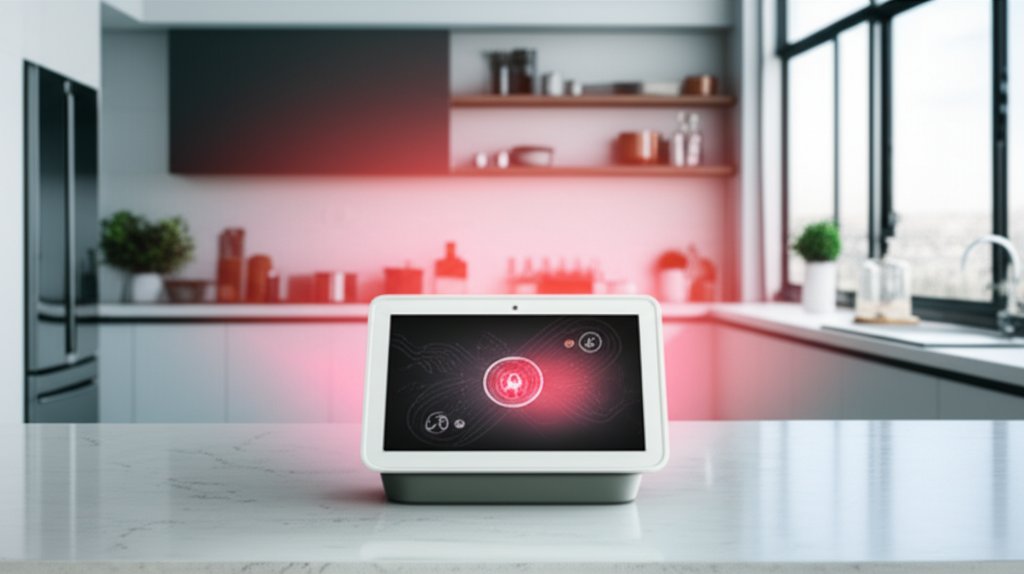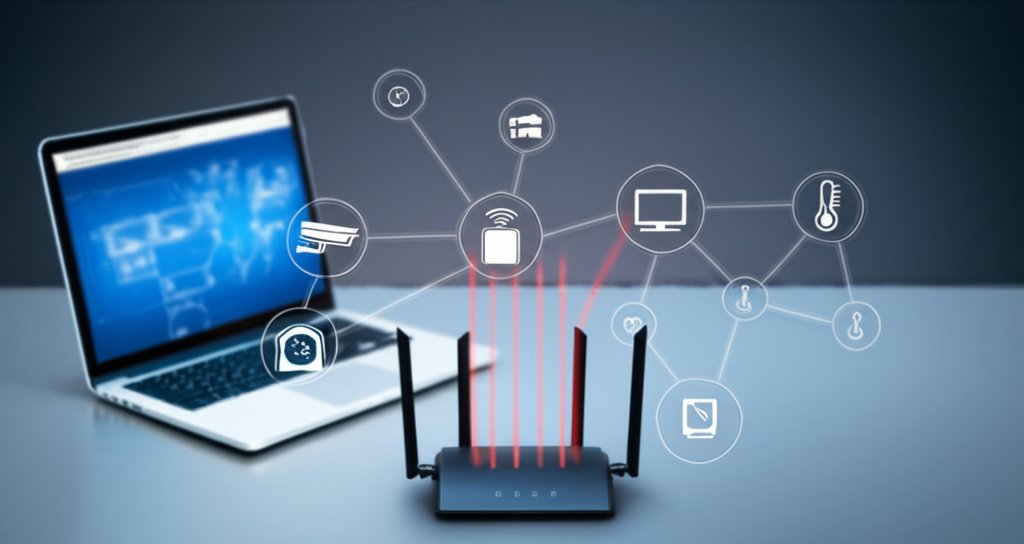Welcome to our deep dive into the fascinating, yet often perilous, world of connected devices. You’ve probably heard the buzz, or perhaps a chilling whisper, about how your everyday smart gadgets could potentially be a privacy nightmare or a significant security risk. Is your smart home indeed vulnerable to smart home device hacking?
While the title might make you think of safeguarding your personal gadgets, this guide isn’t just about tweaking your smart bulb’s settings. We’re going beyond simple user advice. We’re going to explore what it means to truly understand and test the security of these devices, giving you a comprehensive look at the world of IoT Penetration Testing from a professional’s perspective. We’ll demystify the complexities, unpack the ethical considerations, and chart a path for anyone interested in this vital cybersecurity domain. It’s a journey from fundamental principles to advanced IoT penetration testing methods, focusing on how we secure the digital world and protect against emerging IoT security vulnerabilities.
So, if you’re curious about the mechanics of securing IoT, pondering a career in this dynamic field, or simply want to grasp the intricate layers of protection needed for our hyper-connected lives and understand how to prevent connected device security risks, you’ve come to the right place. Let’s get started, and empower you to take control of your digital security.
Table of Contents
Basics: Understanding the Foundation of IoT Security
What is IoT penetration testing, and why is it crucial for preventing smart device hacking?
IoT penetration testing is a controlled, simulated cyberattack on internet-connected devices, conducted to proactively discover IoT security vulnerabilities before malicious actors can exploit them. It’s not just a good practice; it’s absolutely crucial because these devices – ranging from smart thermostats and baby monitors to industrial sensors – often enter the market with weak security postures, making them prime targets for smart home device hacking.
When you’re dealing with IoT devices, you’re not just securing a computer; you’re often protecting physical environments, deeply personal privacy, and even critical infrastructure. Manufacturers, in their rush to innovate and capture market share, frequently deprioritize security, leaving glaring holes like default credentials, unencrypted communication channels, or easily exploitable firmware vulnerabilities. Penetration testing helps us identify these weaknesses, allowing for timely patching and true securing of smart devices across the ecosystem, preventing real attacks that could lead to widespread data breaches, privacy violations, or even physical harm. Believe me, this proactive defense is an investment that pays significant dividends, safeguarding our digital lives.
What legal and ethical considerations must I know before performing an ethical hacking IoT penetration test?
Before you even think about scanning or interacting with an IoT device, you absolutely must obtain explicit, written permission from the device owner. This is non-negotiable; unauthorized testing is not only illegal but also profoundly unethical. It is the fundamental principle that distinguishes legitimate ethical hacking IoT activities from criminal actions.
Professional IoT penetration testing operates under a strict “Rules of Engagement” (ROE) document. This comprehensive document meticulously outlines the scope of the assessment, authorized tools and techniques, testing timelines, and precise reporting procedures. As an ethical tester, you are bound to minimize any potential disruption, scrupulously avoid data destruction, and maintain absolute confidentiality regarding any discovered IoT security vulnerabilities. Responsible disclosure is paramount: you report findings privately to the vendor or owner, allowing them adequate time to fix issues before any public disclosure. Ignoring these principles won’t just jeopardize your career; it could land you in serious legal trouble. We are here to help secure, not to harm – remember that crucial distinction.
How do I set up a safe lab environment for practicing IoT penetration testing methods?
Setting up a dedicated, isolated lab environment is vital for safe and legal practice of IoT penetration testing methods, allowing you to experiment with smart home device hacking scenarios without affecting production systems or violating legal statutes. You’ll need an isolated network where you can test devices without exposing your personal data, corporate infrastructure, or inadvertently impacting other devices. For practical tips on securing home networks, which is crucial for a safe lab, consider our guide.
Typically, this involves using Virtual Machines (VMs) running operating systems like Kali Linux, which comes pre-loaded with many essential ethical hacking tools for IoT. You should segment your lab network using a physically separate router or a VLAN, ensuring your test devices are completely isolated from your main network. Consider acquiring inexpensive, decommissioned, or purpose-built vulnerable IoT devices specifically for testing; never use devices currently in use in your home or business for uncontrolled experimentation. This kind of “IoT security research sandbox” lets you explore IoT security vulnerabilities responsibly, build your skills, and master practical solutions.
To further enhance your skills and explore related content, consider subscribing to our newsletter for exclusive insights into emerging IoT threats and defense strategies, or download our free guide on “Top 10 Steps to Secure Your Smart Home.”
What are some common cybersecurity fundamentals relevant to preventing connected device security risks?
The core cybersecurity fundamentals apply universally, but they are often either overlooked or implemented poorly in IoT devices, creating significant connected device security risks and expansive attack surfaces. These fundamentals include robust authentication, intelligent network segmentation, and regular, timely software updates.
For IoT, we’re talking about pervasive issues like hardcoded default credentials (a huge no-no that facilitates smart home device hacking!), unencrypted communications, and firmware vulnerabilities that rarely receive patches. Understanding principles like the CIA triad (Confidentiality, Integrity, Availability) is crucial in assessing IoT security vulnerabilities. We also need to consider secure boot mechanisms, the potential for hardware tampering, and minimizing the attack surface by disabling unnecessary services and ports. Even your smart doorbell presents unique challenges because it’s both a network device and a physical entry point. It’s about applying tried-and-true security wisdom to a new, often less-secure, frontier to truly secure smart devices, often by adopting Zero Trust principles.
Intermediate: Tools, Techniques, and Common IoT Vulnerabilities
What reconnaissance techniques are effective for discovering IoT devices on a network and identifying potential IoT security vulnerabilities?
Effective reconnaissance for IoT devices involves a blend of passive and active scanning to precisely identify devices, their services, and potential entry points. It’s akin to a security professional carefully casing a building before attempting to find a weak door, window, or ventilation shaft for unauthorized access.
You’ll frequently use tools like Nmap for comprehensive port scanning, which helps identify open ports and services, allowing you to fingerprint device types, operating systems, and even specific firmware versions. Wireshark is invaluable for passive listening, capturing network traffic to reveal unencrypted communications, proprietary protocols, or even exposed credentials. Many IoT devices utilize protocols like UPnP or mDNS, which can inadvertently expose services; therefore, tools specifically designed to scan for these protocols are also immensely helpful. Don’t overlook physical reconnaissance; examining devices for accessible debug ports (e.g., USB, JTAG, UART), model numbers, or FCC IDs can provide crucial information for subsequent firmware analysis IoT. It’s about meticulously piecing together the puzzle of a device’s digital footprint and physical access points to uncover IoT security vulnerabilities.
How do vulnerability assessments differ for IoT devices, and what methodologies are used in an IoT security assessment?
Vulnerability assessments for IoT devices often extend significantly beyond traditional network scans, incorporating specialized techniques like hardware analysis, in-depth firmware analysis IoT and reverse engineering, and comprehensive mobile application testing. It’s a multi-faceted approach because the attack surface of IoT devices is incredibly diverse, encompassing everything from the physical device itself to its cloud backend and companion mobile apps.
We typically follow established methodologies like the OWASP IoT Top 10, which specifically highlights common IoT security vulnerabilities unique to connected devices (e.g., insecure ecosystem interfaces, weak or default credentials, lack of secure update mechanisms). The Penetration Testing Execution Standard (PTES) also provides a robust framework, guiding us through pre-engagement, intelligence gathering, threat modeling, IoT security assessment, exploitation, and post-exploitation. What makes IoT unique is the imperative need to consider supply chain security, the potential for physical tampering, and the complex interaction between the device, its cloud services (often leveraging serverless security paradigms), and associated mobile applications. You’re not just assessing a single endpoint; you’re evaluating an entire interconnected ecosystem to identify and mitigate connected device security risks.
What are common IoT security vulnerabilities I might encounter in smart home device hacking scenarios?
IoT devices frequently suffer from a predictable set of IoT security vulnerabilities, often due to rushed development cycles, inadequate security testing, and a pervasive lack of “security-by-design” principles. These represent the low-hanging fruit for attackers intent on smart home device hacking or broader compromises.
The usual suspects include weak or default credentials (e.g., “admin/admin”), insecure network services (like open Telnet or FTP ports that should be disabled), and outdated or unpatched firmware vulnerabilities with publicly known exploits. Many devices transmit sensitive data without proper encryption, allowing for straightforward Man-in-the-Middle (MitM) attacks. Insecure APIs and cloud interfaces are also rampant, providing easy access points if not rigorously secured. Furthermore, physical vulnerabilities, such as easily accessible debug ports or unencrypted internal storage, can allow an attacker to extract firmware, sensitive configuration data, or even cryptographic keys directly from the device. It’s a sad truth that many IoT devices are built primarily for convenience and speed to market, not for resilience against determined adversaries or robust smart device data privacy.
Which tools are essential for conducting IoT penetration testing?
A robust toolkit for IoT penetration testing blends general cybersecurity tools with specialized hardware and software designed for deep device-specific analysis. You’ll need a versatile arsenal to effectively tackle the myriad attack surfaces present in the IoT ecosystem.
For network and web assessments, you’ll rely heavily on Kali Linux, which includes staple IoT penetration testing tools like Nmap for scanning, Wireshark for detailed packet analysis, and Burp Suite for proxying and testing web interfaces (which are often used by IoT cloud platforms and companion mobile apps). Metasploit is invaluable for exploitation, allowing you to leverage discovered IoT security vulnerabilities. For hardware analysis, you might utilize JTAG/UART debuggers, logic analyzers, and multimeters to interact directly with the device’s circuitry. Firmware analysis IoT often involves tools like Binwalk for extracting filesystems from firmware images and IDA Pro or Ghidra for reverse engineering binaries. It’s a pretty diverse set of IoT penetration testing tools, reflecting the inherently diverse nature of IoT devices themselves and the complex connected device security risks they present.
Advanced: Exploitation, Reporting, and Career Paths in IoT Penetration Testing
What post-exploitation steps are involved after gaining access to an IoT device through an IoT exploitation technique?
Once you’ve successfully exploited an IoT device using an IoT exploitation technique, post-exploitation focuses on comprehensively understanding the extent of access achieved, maintaining persistent access, and escalating privileges where possible. It’s about what you do once you’re “inside” to gather more intelligence, establish control, and assess the true impact of the compromise.
This phase often involves meticulously mapping the device’s internal file system, identifying sensitive data (e.g., encryption keys, user credentials, API tokens, configuration files), and understanding its network connections to other devices or cloud services. You might attempt to pivot to other devices on the network or explore the device’s cloud communication pathways to uncover further IoT security vulnerabilities. Establishing persistence – ensuring you can regain access even after a reboot – is a key goal, often achieved through backdoors, modified firmware, or scheduled tasks. Privilege escalation might be necessary to gain full root-level control over the device. It’s about seeing how far a breach could realistically go and what a determined attacker could achieve once they’ve gotten their foot in the door, exposing potential connected device security risks.
How do I effectively report findings from an IoT penetration test?
Effective reporting is as critical as the IoT penetration test itself; it translates complex technical findings into clear, actionable insights for stakeholders, ultimately driving crucial remediation efforts. A well-structured, professional report empowers clients to truly understand their IoT security vulnerabilities and significantly improve their security posture, preventing smart home device hacking.
Your report should typically include an executive summary tailored for non-technical leadership, detailing the overall risk assessment and key findings without jargon. The technical section will meticulously enumerate each vulnerability, including a clear description, its severity (using standardized CVSS scores), precise proof-of-concept steps to reproduce, and clear, practical recommendations for remediation. Supporting evidence, such as screenshots, code snippets, or log excerpts, is vital. Remember to maintain a professional, objective tone and strictly adhere to responsible disclosure principles. It’s not about showing off your hacking skills; it’s about providing invaluable insight and helping them secure smart devices and their assets.
What certification paths are recommended for an aspiring IoT penetration tester?
For aspiring IoT penetration testers, a blend of foundational cybersecurity certifications and specialized hardware/embedded systems knowledge is crucial. You’re building a multi-disciplinary skillset that combines traditional networking and software security with deep hardware understanding, essential for tackling IoT security vulnerabilities.
Start with foundational certifications like CompTIA Security+ or CySA+ to cement your core cybersecurity knowledge. Then, consider a general penetration testing certification such as EC-Council’s Certified Ethical Hacker (CEH) or, for a more advanced and hands-on approach, Offensive Security Certified Professional (OSCP). For IoT specifically, look into IoT security certifications focusing on embedded systems security, hardware hacking (e.g., relevant courses from Black Hat or DEF CON), or even cloud security (as many IoT devices heavily interact with cloud platforms). Courses from SANS Institute (e.g., SEC573: Automating Information Security with Python) can also be incredibly valuable. It’s a continuous learning journey, and these certifications help validate your expertise in a rapidly evolving field, preparing you for a rewarding career in smart device hacking prevention.
Are there opportunities for bug bounty programs specifically for IoT devices and uncovering smart device data privacy issues?
Yes, bug bounty programs for IoT devices are indeed a growing and exciting area, offering ethical hackers a fantastic chance to earn rewards by responsibly disclosing IoT security vulnerabilities to manufacturers. It’s an excellent way to sharpen your skills, contribute to real-world security, and even uncover critical smart device data privacy issues.
Many major tech companies with IoT products, and even forward-thinking smaller startups, now host bug bounty programs on platforms like HackerOne or Bugcrowd. These programs meticulously specify the scope of testing, the types of IoT security vulnerabilities they are interested in, and the rewards offered. While payouts can vary, discovering critical vulnerabilities in widely used IoT devices can lead to significant financial rewards and substantial recognition within the security community. It’s paramount to carefully read and strictly adhere to the program’s rules of engagement; sticking to the defined scope is absolutely essential to avoid legal repercussions. We’re seeing more and more companies realize the immense value of crowdsourced security for their connected devices, and IoT is definitely a significant part of that accelerating trend.
Related Questions
What does continuous learning look like in the field of IoT security and preventing smart device data privacy breaches?
Continuous learning in IoT security is an absolute necessity because the landscape evolves at a blistering pace, with new devices, communication protocols, and unique IoT security vulnerabilities emerging constantly. If you’re not actively learning, you’re effectively falling behind – that’s just the reality of our dynamic field, especially when trying to prevent smart device data privacy breaches.
This means staying updated with industry news, attending conferences (both virtual and in-person) like Black Hat or DEF CON, and actively participating in cybersecurity communities and forums. Hands-on practice with new devices, experimenting with different IoT exploitation techniques, and diving into firmware analysis IoT for the latest gadgets are also crucial for practical skill development. Platforms like HackTheBox and TryHackMe offer excellent labs to practice ethical hacking IoT skills legally and ethically. Reading whitepapers, following leading security researchers, and even contributing to open-source security projects are all integral parts of this journey. It’s a vibrant, challenging field, and continuous engagement is your best defense against stagnation and ensures you remain effective in securing smart devices.
How can I develop a career in IoT penetration testing, focusing on preventing IoT security vulnerabilities?
Developing a robust career in IoT penetration testing requires a strong foundational understanding of networking, programming, and general cybersecurity principles, combined with a genuine passion for reverse engineering, embedded systems, and hardware. It’s a niche but incredibly rewarding path for those who enjoy complex problem-solving and want to actively contribute to preventing IoT security vulnerabilities.
Start by mastering networking fundamentals and gaining proficiency in at least one scripting language like Python, which is invaluable for automating tasks and developing custom tools. Get hands-on with embedded systems; tinker with Raspberry Pis, Arduinos, or ESP32 boards to understand their architecture. Build your own smart home device hacking lab, practice on intentionally vulnerable devices, and participate in CTFs (Capture The Flag) competitions to hone your practical skills. Seek out internships or entry-level positions in cybersecurity or product security roles. Building a portfolio of your research, even if it’s just on personal projects, can significantly make you stand out. And remember, certifications like OSCP or specialized embedded systems security certifications will definitely boost your resume in this demanding field. It’s a challenging journey, but the demand for skilled IoT pen testers is only growing as our world becomes more connected.
Conclusion
We’ve traversed the intricate landscape of IoT penetration testing, from its foundational principles and ethical boundaries to the technical tools, IoT penetration testing methods, and rewarding career pathways it offers. It’s clear that securing our hyper-connected world from IoT security vulnerabilities and smart home device hacking is an ongoing, vital mission, one that demands a blend of technical prowess, ethical integrity, and a steadfast commitment to continuous learning.
Understanding the inherent weaknesses and potential connected device security risks in IoT devices isn’t just a technical exercise; it’s about protecting personal privacy, ensuring physical safety, and building trust in our rapidly expanding digital infrastructure. As a security professional, I can tell you that the power to identify and proactively mitigate these risks is immensely satisfying and critically important for our collective digital well-being.
Don’t wait for a “nightmare” scenario to spur action. The digital world needs its protectors, and you can be one of them. Start building your skills today, explore the fascinating challenges that IoT security presents, and contribute meaningfully to making our connected future a safer, more resilient one.
Secure the digital world! Begin your journey into ethical hacking IoT with TryHackMe or HackTheBox for legal, hands-on practice, and become a guardian of our connected lives.









